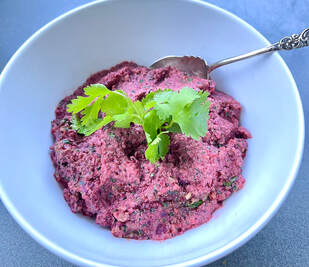
As women age, we lose bone density. While doctors may recommend calcium supplements to build bone and prevent osteoporosis, it's best to get calcium from foods including dark green leafy vegetables, tofu, almonds, canned sardines and salmon with the bones, and dairy. The problem is calcium supplements may raise the risk for heart disease by depositing calcium in blood vessel walls and soft tissues where it can cause dangerous calcifications. Vitamin K2 to the rescue! Remarkably, K2 sweeps calcium out of the blood and into bones, right where we want it! K2 inhibits arterial calcification and stiffening. Also, while our bones cleverly make osteocalcin, a hormone which helps bind calcium to bones to make them stronger (and also improves metabolic and hormonal health and increases exercise performance!), osteocalcin needs K2 to become active and do its job.
K2 in Food
Found in animal foods and microorganisms from fermentation, K2 is a fat-soluble vitamin so is best absorbed when eating foods rich in healthy fats such as olive oil, nuts, seeds, salmon, grass-fed beef, and avocados. K2 is in specific foods, most abundantly in goose liver and natto, a fermented soy bean popular in Japan. Do you eat these? It is also found in smaller quantity in cheeses like Jarlsburg and brie, egg yolks and the dark meat of chicken. It would take 9 ounces of Jarlsburg, close to a pound of dark chicken or a combo of foods to get the recommended 180 to 200 micrograms of K2 daily from food. (Read here for more info.) You may want to ensure you're getting ample K2 in supplement form particularly if you're dairy-free, egg intolerant, and/or dark-meat averse like me.
Supplements
You won't find vitamin K2 in many multivitamins. Instead, you'll find vitamin K1 which is derived from plant foods. The body converts some K1 to K2, but to get enough vitamin K2 to support the health benefits I've mentioned, it may require taking a K2 supplement. Look for it as "MK-7;" this is the form of K2 you'd get from natto, for example. You can also find a combo vitamin D3 + K2 together in one bottle. That's because they work synergistically along with the aid of magnesium to reverse calcifications, channel calcium into bone and support bone strength. And since 80% or more Americans are deficient in magnesium, my favorite recommendation for bone health is D3 + K2 + magnesium + calcium-rich foods. If you're considering taking calcium supplements, protecting yourself with K2, D3 and magnesium is highly recommended.
__________________________________________________________________________________________
BEET PKHALI
For my birthday, my sweet son took me to a cooking class of foods from Uzbekistan. This beet-walnut side dish was our favorite. It's credited to our teacher and cookbook author Anna Voloshyna.
Print Recipe
Serves 8
2 medium raw red beets, or pre-cooked, about 1 pound total
1 1/2 c roasted or warmed walnut halves
1/3 c tightly packed cilantro leaves, plus more for serving
1/2 c tightly packed flat-leaf parsley leaves
2 garlic cloves, minced
1 T good balsamic vinegar
1 T pomegranate molasses (find in a mediterranean store or online)
1/2 t ground coriander
1/2 t ground fenugreek
3/4 t salt
a few grinds of freshly ground pepper
2 T pomegranate seeds for garnish, optional
Cover raw beets with water in a pot. Bring to a boil over medium-high heat. Cook until beets are easily pierced with a knife, about 30-40 minutes. Drain beets and cool for 10 minutes. Chop when cool.
In a food processor, combine all ingredients except beets and pomegranate seeds. Pulse until the walnuts and herbs are finely chopped. Add beets and pulse again until you have a thick paste. Top with pomegranate seeds, if using, and cilantro leaves. Enjoy!
